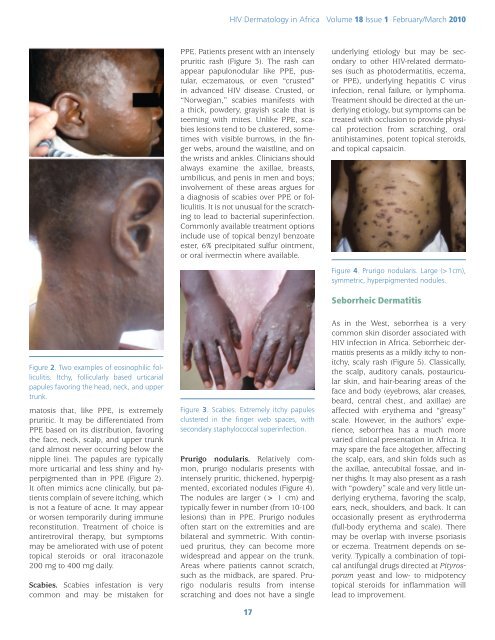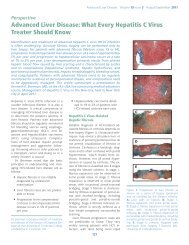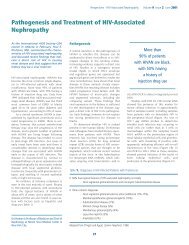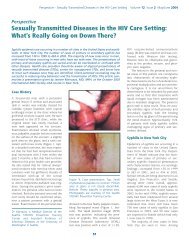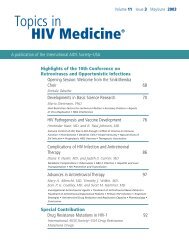Dermatologic Manifestations of HIV in Africa - International AIDS ...
Dermatologic Manifestations of HIV in Africa - International AIDS ...
Dermatologic Manifestations of HIV in Africa - International AIDS ...
You also want an ePaper? Increase the reach of your titles
YUMPU automatically turns print PDFs into web optimized ePapers that Google loves.
<strong>HIV</strong> Dermatology <strong>in</strong> <strong>Africa</strong> Volume 18 Issue 1 February/March 2010<br />
PPE. Patients present with an <strong>in</strong>tensely<br />
pruritic rash (Figure 3). The rash can<br />
appear papulonodular like PPE, pustular,<br />
eczematous, or even “crusted”<br />
<strong>in</strong> advanced <strong>HIV</strong> disease. Crusted, or<br />
“Norwegian,” scabies manifests with<br />
a thick, powdery, grayish scale that is<br />
teem<strong>in</strong>g with mites. Unlike PPE, scabies<br />
lesions tend to be clustered, sometimes<br />
with visible burrows, <strong>in</strong> the f<strong>in</strong>ger<br />
webs, around the waistl<strong>in</strong>e, and on<br />
the wrists and ankles. Cl<strong>in</strong>icians should<br />
always exam<strong>in</strong>e the axillae, breasts,<br />
umbilicus, and penis <strong>in</strong> men and boys;<br />
<strong>in</strong>volvement <strong>of</strong> these areas argues for<br />
a diagnosis <strong>of</strong> scabies over PPE or folliculitis.<br />
It is not unusual for the scratch<strong>in</strong>g<br />
to lead to bacterial super<strong>in</strong>fection.<br />
Commonly available treatment options<br />
<strong>in</strong>clude use <strong>of</strong> topical benzyl benzoate<br />
ester, 6% precipitated sulfur o<strong>in</strong>tment,<br />
or oral ivermect<strong>in</strong> where available.<br />
underly<strong>in</strong>g etiology but may be secondary<br />
to other <strong>HIV</strong>-related dermatoses<br />
(such as photodermatitis, eczema,<br />
or PPE), underly<strong>in</strong>g hepatitis C virus<br />
<strong>in</strong>fection, renal failure, or lymphoma.<br />
Treatment should be directed at the underly<strong>in</strong>g<br />
etiology, but symptoms can be<br />
treated with occlusion to provide physical<br />
protection from scratch<strong>in</strong>g, oral<br />
antihistam<strong>in</strong>es, potent topical steroids,<br />
and topical capsaic<strong>in</strong>.<br />
Figure 4. Prurigo nodularis. Large (> 1 cm),<br />
symmetric, hyperpigmented nodules.<br />
Seborrheic Dermatitis<br />
Figure 2. Two examples <strong>of</strong> eos<strong>in</strong>ophilic folliculitis.<br />
Itchy, follicularly based urticarial<br />
papules favor<strong>in</strong>g the head, neck, and upper<br />
trunk.<br />
matosis that, like PPE, is extremely<br />
pruritic. It may be differentiated from<br />
PPE based on its distribution, favor<strong>in</strong>g<br />
the face, neck, scalp, and upper trunk<br />
(and almost never occurr<strong>in</strong>g below the<br />
nipple l<strong>in</strong>e). The papules are typically<br />
more urticarial and less sh<strong>in</strong>y and hyperpigmented<br />
than <strong>in</strong> PPE (Figure 2).<br />
It <strong>of</strong>ten mimics acne cl<strong>in</strong>ically, but patients<br />
compla<strong>in</strong> <strong>of</strong> severe itch<strong>in</strong>g, which<br />
is not a feature <strong>of</strong> acne. It may appear<br />
or worsen temporarily dur<strong>in</strong>g immune<br />
reconstitution. Treatment <strong>of</strong> choice is<br />
antiretroviral therapy, but symptoms<br />
may be ameliorated with use <strong>of</strong> potent<br />
topical steroids or oral itraconazole<br />
200 mg to 400 mg daily.<br />
Scabies. Scabies <strong>in</strong>festation is very<br />
common and may be mistaken for<br />
Figure 3. Scabies. Extremely itchy papules<br />
clustered <strong>in</strong> the f<strong>in</strong>ger web spaces, with<br />
secondary staphylococcal super<strong>in</strong>fection.<br />
Prurigo nodularis. Relatively common,<br />
prurigo nodularis presents with<br />
<strong>in</strong>tensely pruritic, thickened, hyperpigmented,<br />
excoriated nodules (Figure 4).<br />
The nodules are larger (> 1 cm) and<br />
typically fewer <strong>in</strong> number (from 10-100<br />
lesions) than <strong>in</strong> PPE. Prurigo nodules<br />
<strong>of</strong>ten start on the extremities and are<br />
bilateral and symmetric. With cont<strong>in</strong>ued<br />
pruritus, they can become more<br />
widespread and appear on the trunk.<br />
Areas where patients cannot scratch,<br />
such as the midback, are spared. Prurigo<br />
nodularis results from <strong>in</strong>tense<br />
scratch<strong>in</strong>g and does not have a s<strong>in</strong>gle<br />
17<br />
As <strong>in</strong> the West, seborrhea is a very<br />
common sk<strong>in</strong> disorder associated with<br />
<strong>HIV</strong> <strong>in</strong>fection <strong>in</strong> <strong>Africa</strong>. Seborrheic dermatitis<br />
presents as a mildly itchy to nonitchy,<br />
scaly rash (Figure 5). Classically,<br />
the scalp, auditory canals, postauricular<br />
sk<strong>in</strong>, and hair-bear<strong>in</strong>g areas <strong>of</strong> the<br />
face and body (eyebrows, alar creases,<br />
beard, central chest, and axillae) are<br />
affected with erythema and “greasy”<br />
scale. However, <strong>in</strong> the authors’ experience,<br />
seborrhea has a much more<br />
varied cl<strong>in</strong>ical presentation <strong>in</strong> <strong>Africa</strong>. It<br />
may spare the face altogether, affect<strong>in</strong>g<br />
the scalp, ears, and sk<strong>in</strong> folds such as<br />
the axillae, antecubital fossae, and <strong>in</strong>ner<br />
thighs. It may also present as a rash<br />
with “powdery” scale and very little underly<strong>in</strong>g<br />
erythema, favor<strong>in</strong>g the scalp,<br />
ears, neck, shoulders, and back. It can<br />
occasionally present as erythroderma<br />
(full-body erythema and scale). There<br />
may be overlap with <strong>in</strong>verse psoriasis<br />
or eczema. Treatment depends on severity.<br />
Typically a comb<strong>in</strong>ation <strong>of</strong> topical<br />
antifungal drugs directed at Pityrosporum<br />
yeast and low- to midpotency<br />
topical steroids for <strong>in</strong>flammation will<br />
lead to improvement.


